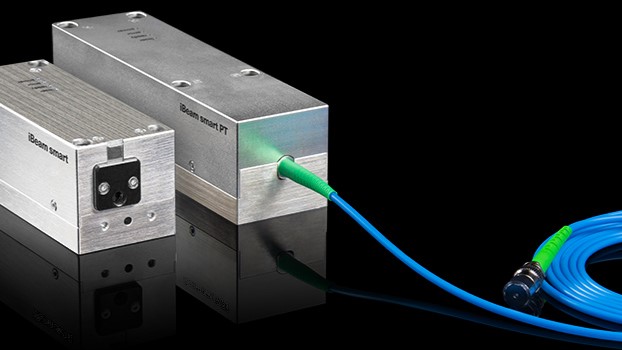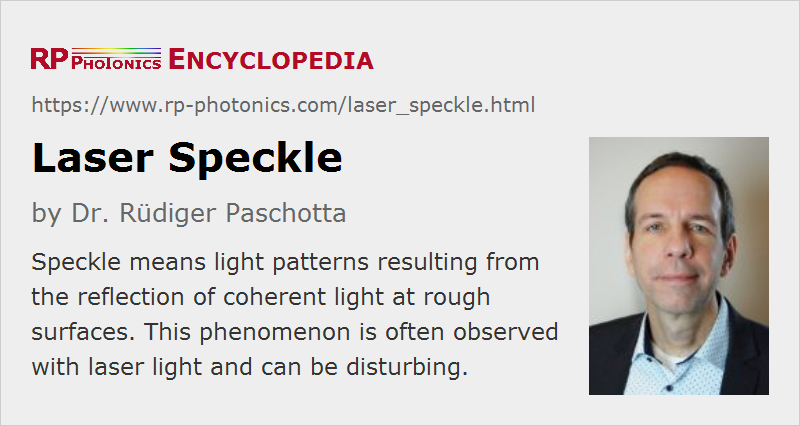Laser Speckle
Definition: light patterns resulting from the reflection of coherent light at rough surfaces
Author: Dr. Rüdiger Paschotta
Cite the article using its DOI: https://doi.org/10.61835/018
Get citation code: Endnote (RIS) BibTex plain textHTML
The term speckle refers to a random granular pattern which can be observed e.g. when a highly coherent light beam (e.g. from a laser) is diffusely reflected at a surface with a complicated (rough) structure, such as a piece of paper, white paint, a display screen, or a metallic surface. This phenomenon results from the interference of many different reflected portions of the incident beam with random relative optical phases. Even minor changes of the conditions, such as of the illuminated spot or the direction of the incident laser beam, can change the detailed shape of a speckle pattern.
It can be shown that under most conditions laser speckle exhibit so-called Rayleigh statistics. This means that the probability of finding a certain intensity at a certain location in a speckle pattern decays exponentially with increasing intensity: the probability density is
$$p(I) = \frac{{\exp ( - I/\left\langle I \right\rangle )}}{{\left\langle I \right\rangle }}$$where <$\langle I \rangle$> is the average intensity.
Speckle patterns can severely degrade the image quality of laser projection displays, or disturb position measurements with laser pointers. Speckle can often be avoided, e.g. by using a light source with sufficiently large optical bandwidth (short coherence length) such as a superluminescent source. (How much bandwidth is required for that purpose depends on the situation.) For projection displays, one may also work with an optimized screen. However, there are also applications of speckle, e.g. in speckle interferometry.
The complicated intensity patterns observed at the ends of multimode fibers are also sometimes called speckle. They result from the interference of many propagation modes, where the relative phases depend on the detailed launching conditions.
More to Learn
Encyclopedia articles:
Blog articles:
Suppliers
The RP Photonics Buyer's Guide contains six suppliers for laser speckle reduction components. Among them:


Edmund Optics
Optotune laser speckle reducers remove local interferences and significantly reduce speckle noise in laser systems by dynamically diffusing the laser beam. Offering a compact size, integrated drive electronics, and vibration-less speckle reduction, Optotune laser speckle reducers are ideal for beam homogenization, 3D scanning, metrology, microscopy, and interferometry.


TOPTICA Photonics
TOPTICA's SKILL function reduces speckle in single-mode diode lasers. By decreasing the longitudinal coherence lengths of the emitted light, the speckle generating mutual interference of wavefronts is also reduced. Thus annoying speckle noise on detectors and imaging systems can be lowered to a minimum.
Bibliography
| [1] | R. V. Langmuir, “Scattering of laser light”, Appl. Phys. Lett. 2, 29 (1963); https://doi.org/10.1063/1.1753756 |
| [2] | J. W. Goodman, “Some fundamental properties of speckle”, J. Opt. Soc. Am. 66 (11), 1145 (1976); https://doi.org/10.1364/JOSA.66.001145 |
| [3] | K. Creath, “Phase-shifting speckle interferometry”, Appl. Opt. 24 (18), 3053 (1985); https://doi.org/10.1364/AO.24.003053 |
| [4] | B. Shapiro, “Large intensity fluctuations for wave propagation in random media”, Phys. Rev. Lett. 57, 2168 (1986); https://doi.org/10.1103/PhysRevLett.57.2168 |
| [5] | Justin Dove and Jeffrey H. Shapiro, “Speckled speckled speckle”, Opt. Express 28 (15), 22105 (2020); https://doi.org/10.1364/OE.398226 |
| [6] | J. C. Dainty, Laser Speckle and Related Phenomena, Springer, Berlin (1975) |
Questions and Comments from Users
Here you can submit questions and comments. As far as they get accepted by the author, they will appear above this paragraph together with the author’s answer. The author will decide on acceptance based on certain criteria. Essentially, the issue must be of sufficiently broad interest.
Please do not enter personal data here; we would otherwise delete it soon. (See also our privacy declaration.) If you wish to receive personal feedback or consultancy from the author, please contact him, e.g. via e-mail.
By submitting the information, you give your consent to the potential publication of your inputs on our website according to our rules. (If you later retract your consent, we will delete those inputs.) As your inputs are first reviewed by the author, they may be published with some delay.

 general optics
general optics

2023-05-26
What happens when light scattered from a diffuse surface (speckle) is coupled into a single-mode fiber?
The author's answer:
Only the light fitting to the guided mode of the fiber will be guided, and at the same time you see only light with that mode profile (but possibly not much optical power).